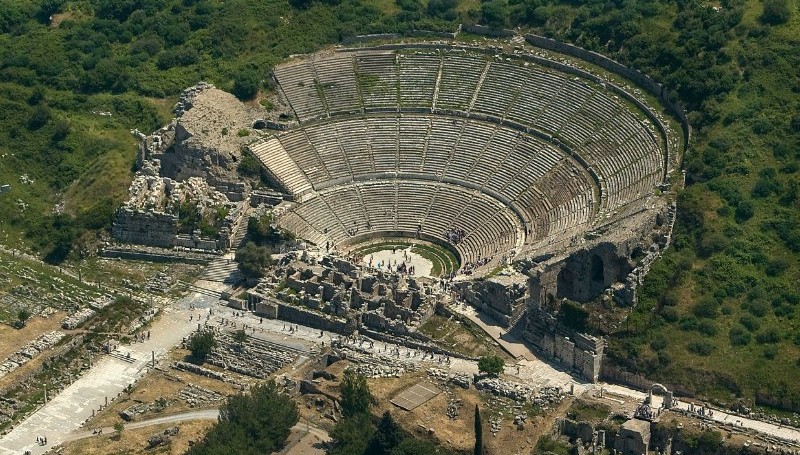Большой Театр Эфеса
The Great Theatre, with its capacity of 25,000 spectators, was the biggest in Asia Minor and, after the Coliseum in Rome, the second largest in the Roman Empire. Built into the side of Mount Panayir it is the largest structure in Ephesus, measuring 300 metres x 150 metres overall and, clearly visible from the Kusadasi to Selcuk road, it is still impressive today.
The first theatre was constructed in the classic "U" shape in the third century BC during the reign of Lysimachos and then enlarged and improved several times in the Roman era. The seating area or cavea had sixty-six rows of seats divided into three blocks by two horizontal aisles or diazoma. The lower rows of seats, close to the emperor’s box, had marble back supports and were reserved for the most important citizens.
The skene or stage building was of three stories and 18 metres high. The ground floor had eight rooms off a single corridor. The second storey, added by Nero in the First Century AD, was decorated with pillars, statues and relief carvings on the side facing the audience. The third was added late in the second Century AD by Septimus Severus. Five entrances open from the skene onto the semicircular orchestra, where the chorus sang. The central entrance was wider than the others to enhance the appearance of the stage and to make it seem larger and more monumental.
The theatre was initially used to stage concerts and plays then later for political, religious and philosophical meetings and gladiatorial contests. Christians were also tortured here by being forced to fight wild animals. Saint Paul was judged and sent to prison here for damaging the reputation of the Goddess Artemis and her followers.
An earthquake in the Fourth Century AD partly destroyed the theatre and it was only partly restored. Some of the seats were used to repair other buildings; stone was later taken for the construction of Saint John’s Basilica. In 413 AD, Christianity was adopted as the official religion of the Roman Empire and more materials were taken to construct the Persecution Gate to symbolise and commemorate the suffering of those early Christians tortured and killed in the theatre.
The theatre is still in use today and has seen recent performances by Diana Ross, Joan Baez, Chris de Burgh, Bryan Adams, Elton John, Sting, Julio Iglesias, and Luciano Pavarotti, as well as many classical concerts.

